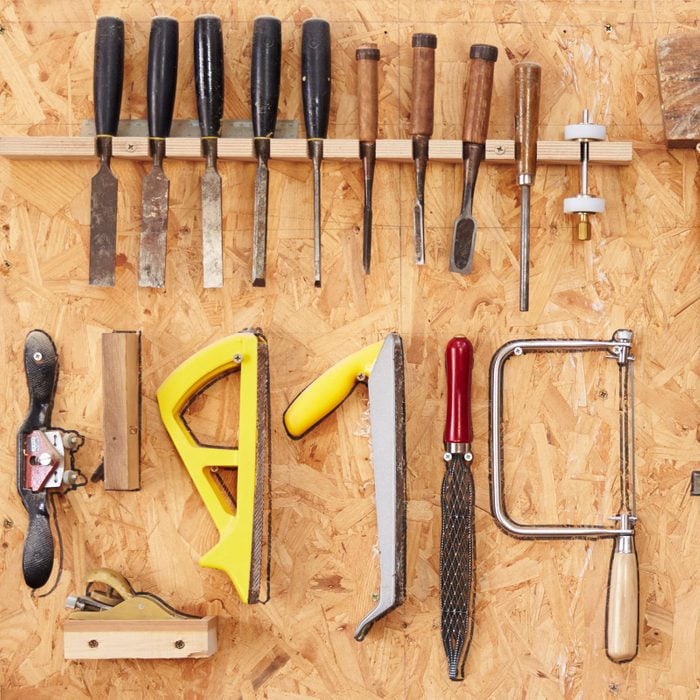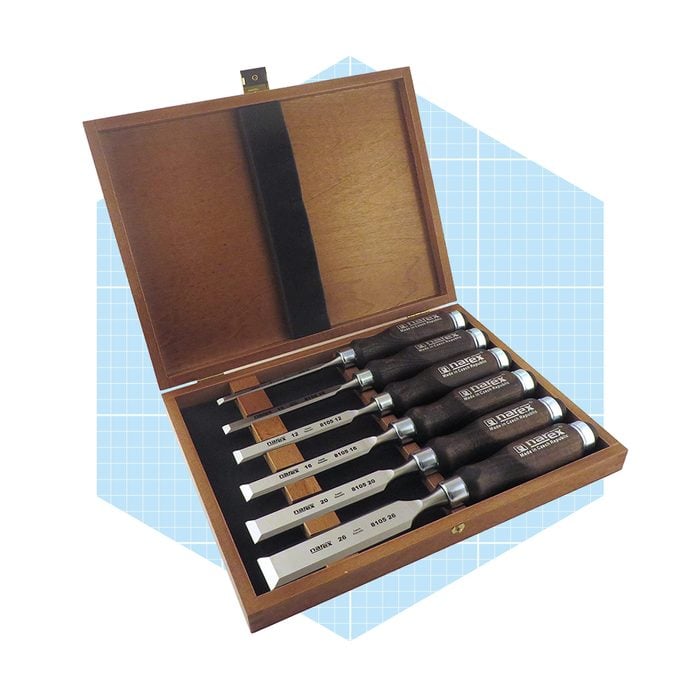
Best Overall Bench Woodworking Chisel Set
Narex Boxed Bench Chisel Set
Pros:
- Extremely durable tempered steel
- Easy to transport
- Box keeps chisels protected
Cons:
- More expensive than other options
With a range of six sizes and high-quality construction, the Narex Boxed Bench Chisel Set is one of the best wood chisels you can buy. Their beechwood handles provide a sturdy grip while you work. Thanks to the steel ferrules, the tang handles are durable enough to take a beating. The included storage box keeps these valuable woodworking tools protected while not in use, and a foam interior prevents them from rolling around.
Size (mm): 6, 10, 12, 16, 20, 26
Type: Bench
Handle: Beech
Material: Alloy Steel
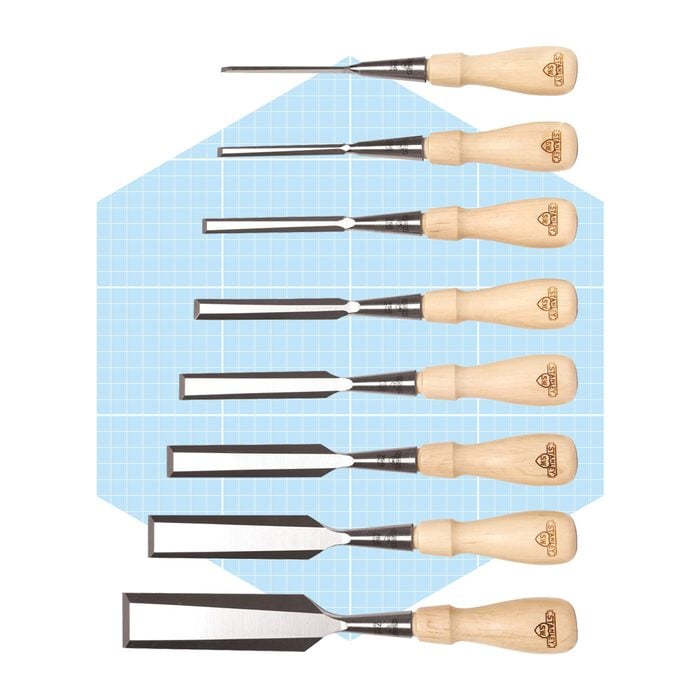
Best Full Bench Set of Woodworking Chisels for Beginners
Stanley Sweetheart Chisel Set
Pros:
- Wide range of sizes
- Long blades are convenient for a variety of projects
- Comfortable hornbeam handle
Cons:
- Relatively expensive
If you’re just starting your chisel collection, the high-quality, versatile Stanley Sweetheart Chisel Set is a great choice. These eight chisels range from 1/8- to 1-1/4-inches, and their beveled edges can tackle a variety of chiseling tasks. A soft-sided leather tool roll protects this set. It’s easier to store and transport than a wood or plastic storage box.
Size (in.): 1/8, 1/4, 3/8, 1/2, 5/8, 3/4, 1, 1 1/4
Type: Bench
Handle: Hornbeam
Material: Carbon Steel
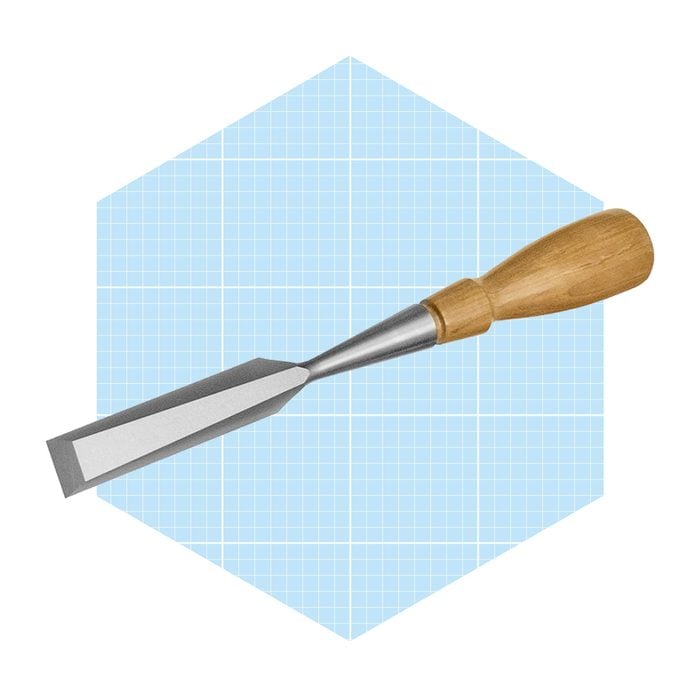
Best Single Woodworking Chisel
Lie-Nielsen 1/2-in. Bevel Chisel
Pros:
- 3/4 size covers a variety of tasks
- Will last a very long time
- Great start to a professional collection
Cons:
- Very Expensive
- Users will still need additional pieces
If you’re more interested in quality over quantity, take a look at the Lie-Nielsen 1/2-in. Bevel Chisel. It’s versatile enough for a wide range of wood shaping and sculpting tasks, and the Lie-Nielson brand is synonymous with high quality.
The socket handle ensures this chisel can take a pounding. It’s made of especially tough and sturdy hornbeam wood, good for whacking with a mallet. If any issues arise, Lie-Neilson guarantees its material and workmanship for life.
Size (in.): 3/4
Type: Bench
Handle: Hornbeam
Material: Double-tempered hardened steel
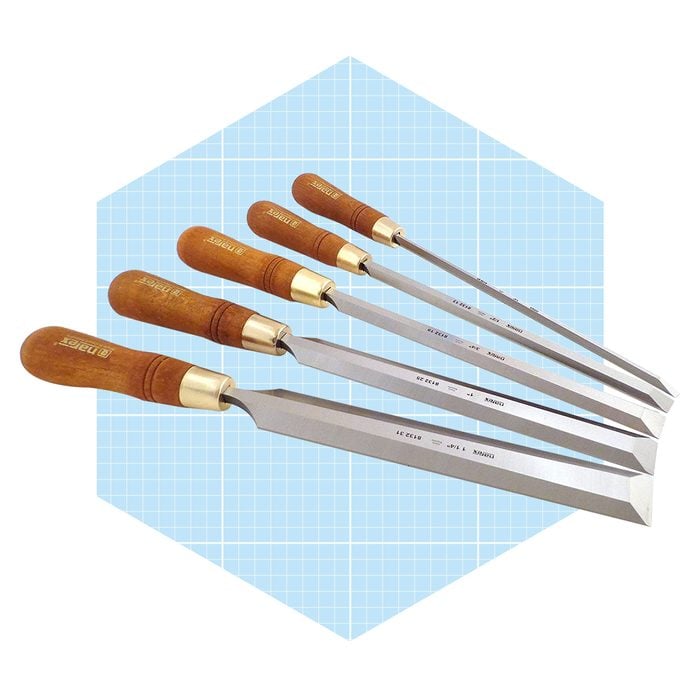
Best Paring Woodworking Chisels
Narex Paring Chisels
Pros:
- Long blades are easy to control
- Attractive hornbeam and brass handles
Cons:
- Very expensive
- No storage container provided
A low bevel angle (20 degrees) and long blade length (9-5/8-in.) make these Narex Paring Chisels good for precise paring jobs with minimal user effort.
The length makes these woodworking hand tools easy to use in tight or awkward areas. The sturdy, waxed hornbeam handle provides the grip needed for precise cuts and edge-grain work. They’re available in five sizes, from 1/4- to 1-1/4-inches.
Size (in.): 1/4, 1/2, 3/4, 1, 1 1/4
Type: Paring
Handle: Hornbeam
Material: Alloy Steel
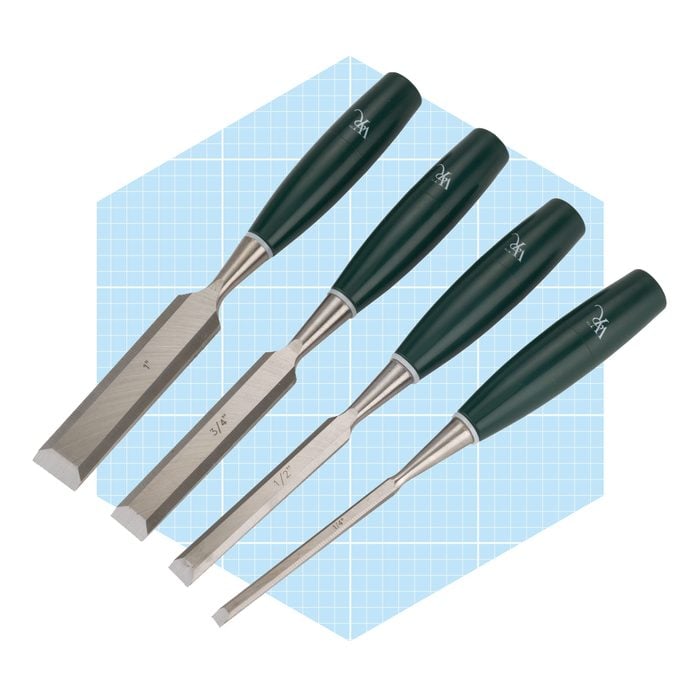
Best Plastic Handle Woodworking Chisels
WoodRiver Chisels
Pros:
- Budget-friendly price
- Durable handles won’t crack or splinter
Cons:
- Not as comfortable to use as wood-handled versions
This set of WoodRiver Chisels features durable polypropylene handles. At the ridiculously low price of $22, it’s great for beginners or seasoned professionals who want an extra set.
The beveled edges make these one of the best wood chisels, and they fit easily into joints and tight spaces, and they come in a useful range of sizes (1/4-in. to 1-inch). Note: They may take some time to hone and sharpen.
Size (in.): 1/4, 1/2, 3/4, 1
Type: Bench
Handle: Polypropylene
Material: Alloy Steel
What to Consider When Buying a Woodworking Chisel
When shopping for chisels, consider these factors:
- Size: Chisel size refers to the width of the blade. Depending on potential use and your desired productivity level, size is important. If you’re building your chisel collection from scratch, go with a bench chisel set that includes 1/4-, 1/2-, 3/4- and 1-inch sizes.
- Storage: Although chisels handle relatively rugged tasks, their blades are delicate and their edges can be easily damaged if they’re not stored correctly. If you lack safe storage space for chisels, consider buying a set that comes with a pouch, roll or box.
- Handle type: There are two types, socket and tang. Socket chisels feature a cone-shaped handle that fits into the hollow receiver of the metal blade. Tang chisels are the inverse, with a metal cone that fits into a hollowed handle. Socket chisels are typically more durable and last longer than tangs, so they’re a better choice for frequent, demanding use. Tang handles should be fine for most users. “Comfort is key; choose a handle that feels good in your hand and provides good control,” says Palla.
- Handle material: Wood is the most common. It provides a sturdy, natural grip along with an attractive, rustic look. Plastic handles lack this tactile benefit, although they’re usually significantly cheaper and can take more of a beating than wooden options.
- Sharpening required: Most chisels require honing and sharpening, and you can consult buyer reviews for insight. Some high-end chisels will be ready to use practically right out of the box. Regardless of the chisel you choose, you’ll need to know how to sharpen a chisel correctly.
Why You Should Trust Us
I’m a freelance writer specializing in the home improvement, DIY, and appliance space. Having spent more than five years as a residential and commercial carpenter in NYC–specializing in custom furniture construction and installation–I use my hands-on experience and expert insight to craft product reviews, buying guides, and how-to articles. I’ve written for CNN Underscored, Business Insider and Popular Mechanics, in addition to Family Handyman.
We consulted Jeff Palla, the President of Mr. Handyman, a Neighborly company. Mr. Handyman is a home services company that repairs, maintains and enhances properties. Nearly 1 million homeowners have trusted Mr. Handyman since 1996 for home improvement and repair, providing virtually any home repair, installation, and maintenance service. Jeff joined Neighborly with more than 25 years of senior operations leadership experience and received a Master of Public Administration (MPA) degree and an undergraduate degree in marketing from the University of Central Florida.
FAQs
How to Sharpen a Wood Chisel
The best wood chisels are ones that are sharp enough to do their job correctly and efficiently, so it’s important to regularly sharpen your chisel to maintain its edge. According to Palla, older chisels require cleaning, sharpening and sometimes reshaping, while newer chisels can be maintained with routine sharpening and proper storage.
Sharpening can take some time at first, but with some practice, and a honing guide, you’ll be able to complete the process quickly. Create your own sharpening surface by purchasing a glass shelf—an extremely flat surface is key here—and using a spray adhesive to glue a sheet of 80-grit sandpaper to it. Set the honing guide to your preferred bevel, and pull the chisel across the paper to sharpen it.
Eventually, a “wire edge” or burr, will begin to form, indicating that the bevel has come to a point. Peel off the 80-grit and apply the 220-grit sheet, flip the chisel over and run it flat across the paper a few times to remove the wire edge. Repeat the process with the 150-grit paper. If your glass is big enough, you can apply all three sheets and not bother with swapping them out.
How to Use a Wood Chisel
Despite its simple design, some technique is required to use your chisel correctly.
If you’re creating a shallow mortise cut to make a recess for a strike plate, for example, first score the edges of the cut with a utility knife. Then, orient your chisel vertically—bevel facing into the cutting area—and tap with a mallet to cut across the grain on these edges. Flip the chisel over—bevel side down—so that the edge is slightly angled into the wood, and begin tapping the end with a mallet to remove thin slivers of wood.
For paring cuts—removing thin slices of wood to flatten an open-sided recess—keep the bevel facing up, and keep the back flat against the wood. You should be able to use your own strength to perform these cuts, with no mallet necessary.
For heavy-duty chopping cuts—removing large chunks of wood—keep the back of the chisel flat against the side of the cut, and chop down vertically, using a hammer to generate the necessary force. If you’re creating a long channel for joint work, use a saw to cut the two edges to your preferred depth, and then alternate chopping and paring cuts to remove the waste wood in the middle.
What Size Wood Chisel Do I Need?
The best wood chisel size depends on the type and scope of the woodworking project you’re going to be using it for. If you’re not sure, a basic chisel set of 1/4, 3/8, 1/2 and 3/4-inch options should have you prepared for the majority of chiseling tasks. If you know you’ve got a heavy-duty chopping project, a one-inch model could also be an efficient addition to your collection.

